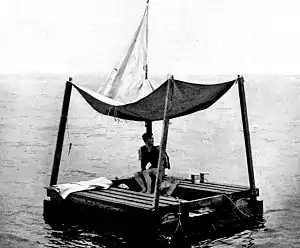Poon Lim | |
|---|---|
 | |
| Born | 8 March 1918 Hainan, China |
| Died | 4 January 1991 (aged 72) Brooklyn, New York, US |
| Allegiance | |
| Branch | |
| Ship | Benlomond |
Known for | Survived for 133 days in a life raft at sea as a castaway |
| Awards | British Empire Medal |
Poon Lim BEM (Chinese: 潘濂; pinyin: Pān Lián; 8 March 1918 – 4 January 1991) was a Chinese seafarer. He was born on the island of Hainan, China. In 1942–43 he survived 133 days alone in the South Atlantic.[1][2]
Lim was Second Mess Steward on SS Benlomond, a British cargo ship that the German submarine U-172 sank on 23 November 1942. He survived on an eight-foot (2.4 m) wooden raft with supplies. When the supplies ran low, Lim resorted to fishing, catching seabirds, and rainwater collection.
On 5 April 1943, three Brazilian fishermen rescued Lim as he neared the coast of Brazil. After Lim returned to the United Kingdom, King George VI awarded him the British Empire Medal. After the Second World War, Lim emigrated to the United States.
Shipwreck
In 1942 Lim was Second Mess Steward on the Ben Line cargo ship Benlomond,[3] which was en route from Suez to New York via Cape Town and Paramaribo.[4] Her officers were British, but most of her crew was Chinese.[3] Benlomond was capable of about 12 knots (22 km/h).[5] She was defensively armed, but her voyage was unescorted.
On 23 November, U-172 intercepted and hit Benlomond with two torpedoes at position 0°18′N 38°27′W / 00.30°N 38.45°W, about 250 miles (400 km) north of the coast of Brazil.[4] Lim, who was in his cabin, took his life jacket and went to his boat station, where two officers and a seaman were trying to launch one of the lifeboats. They had raised the boat off its chocks, and were about to lower it, when Lim was washed overboard. The ship sank within about two minutes of being hit, and Lim was dragged underwater. When he resurfaced, he found only a few planks floating, one of which he used for extra buoyancy.[6]
After about two hours in the water, Lim found and boarded a wooden life raft. In the distance he saw another raft, carrying four or five men, who waved to him to join them. Lim thought they were some of the ship's DEMS gunners. But Lim had no means to propel his raft, and the two rafts drifted apart.[6]
Survival
The raft was stocked with a can of fresh water containing 10 imperial gallons (45 litres), six boxes of hardtack, 2 pounds (0.9 kg) of chocolate, ten cans of pemmican, five cans of evaporated milk, one bottle of lime juice, and one can of massage oil. It also had flares, two smoke pots, and a flashlight, with which to signal for help.[6][7]

Lim at first kept himself alive by drinking the water and eating the food on the raft, but later resorted to fishing, catching seabirds, and collecting rainwater in a canvas life jacket covering. He could not swim well, and often tied a rope from the boat to his wrist in case he fell into the sea. He took a spring from the flashlight and made it into a fishhook, unravelled hemp rope to make a fishing line, and crushed pieces of hardtack to make bait. He dug a nail from the boards on the wooden raft to make a stronger fish hook. When he caught a small fish, he used it as bait to catch bigger fish. He improvised a knife from part of a pemmican can. The water tank had an iron key, which Lim also used as a tool. When gulls settled on his raft, he caught and killed them. He soaked their meat in seawater to salt it, then dried it on deck to make jerky.[8]
When Lim saw sharks, he caught one,[8] using the remnants of gulls he had caught as bait. Lim had braided his fishing line to double thickness, and had wrapped his hands in canvas to give them a little protection. The shark attacked him after he hauled it aboard the raft, so he used a water container to beat it to death. Lim cut it open and sucked the blood from its liver. This quenched his thirst, since it had not rained and he was out of water. He sliced off the fins and let them dry in the sun.
Lim had lost all of his clothes except his shirt and vest. He made a skirt from a hessian bag that had contained the lime juice bottle.[6] The raft had four poles and a canvas tarpaulin, which he rigged as a canopy. This both protected him from the sun and caught rainwater.[6]
Lim once saw a submarine on the surface, with a flag painted on its conning tower. He made out the colours white and green on the flag. Lim called for help, but the crew laughed at him and waved him away.[6] On other occasions, the crews of cargo ships saw him but did not pick him up or even greet him despite his proficient shouts in English. Lim contended that they would not rescue him because he was Asian and they may have assumed he was a stricken Japanese sailor, although another explanation is that German U-boats were rumored to set a "survivor" on a raft as a trap to get a rescuing ship to stop, which made it a sitting duck to be sunk.[8]
Once or twice, United States Navy patrol planes did see him,[6] and one dropped a marker buoy in the water. The plane reported back to US Navy authorities in Belém, Brazil, but a storm hit the area at the same time and he was lost again.
At first, he counted the days by tying knots in a rope, but later decided that there was no point in counting the days and simply began counting full moons.
Rescue
.jpg.webp)
By April 1943, Lim realized that he was nearing land, as the color of the sea was no longer a deep ocean blue. He had drifted westward about 750 miles (1,210 km). On 5 April three Brazilian fishermen found him, about 9 nautical miles (16 km) off the coast of Pará, east of Salinas. He was the sole survivor from Benlomond. Her Master, Captain John Maul had died, along with 43 of her officers and men, and all eight of her gunners.[4]
Lim had lost 20 pounds (9 kg) in weight.[9] He was so weak that his rescuers had to lift him off his raft. But he ate well, and when the fishermen landed him at Belém, three days later, he was able to walk again, although he was still weak.[6]
On 10 April the British Consul in Pará telegraphed a report to the Ministry of War Transport in London, seeking confirmation of the loss of Benlomond. After two weeks in a Brazilian hospital, Lim was fit enough to travel.[6] The Consul arranged for him to go to Britain via Miami and New York.
Aftermath
At a ceremony at the Seamen's Church Institute of New York and New Jersey in New York on 16 July 1943, the Acting British Consul told Lim that King George VI was to award him the British Empire Medal.[10] His citation states that "Poon Lim displayed exceptional courage, fortitude and resource in overcoming the tremendous difficulties with which he was faced during the long and dangerous voyage on the raft".[11] At the same ceremony, Ben Line presented Lim with a gold wristwatch.[10] The Royal Navy incorporated his tale into manuals of survival techniques.
After the war, Lim wanted to emigrate to the United States, but the quota for Chinese immigrants had been reached. However, because of his fame and the aid of Senator Warren Magnuson, he received a special dispensation and eventually gained citizenship.[12] Lim applied to join the US Navy. His application was declined because he had flat feet.[6]
When told no one had ever survived longer on a raft at sea, Lim replied, "I hope no one will ever have to break that record".[10] People have since lived longer lost at sea: three Mexican sailors floated for 10 months from 2005 to 2006 in the Pacific Ocean in a disabled fishing boat.[13] In a similar situation, José Salvador Alvarenga, a fisherman from El Salvador, was apparently lost for 439 days, floating from Mexico to the Marshall Islands. As of 2021, no one has broken Lim's record on a life raft.
The writer Alfred Bester later stated that Lim's ordeal was used in his novel The Stars My Destination, which opens with a man stranded in space.[14]
See also
- José Salvador Alvarenga – survived 438 days adrift in the Pacific Ocean
- Maurice and Maralyn Bailey – survived 117 days adrift in the Pacific Ocean
- Cornelis van der Slot, Nicolaas Hoogendam and Basil Izzi – survived 83 days on a raft in the Atlantic Ocean
- Steven Callahan – survived 76 days adrift in the Atlantic Ocean
- Louis Zamperini – survived 47 days adrift in the Pacific Ocean
- Dougal Robertson – survived 38 days adrift in the Pacific Ocean
- List of people who disappeared mysteriously at sea
Footnotes
- ↑ "In their disabled boat, 3 Mexicans drift 9 months across Pacific". International Herald Tribune. 2006. Retrieved 24 April 2008.
- ↑ United Press (25 May 1943). "Tells of 132 Days on Raft". The New York Times. Retrieved 24 April 2008.
- 1 2 Helgason, Guðmundur. "Crew list: Benlomond". uboat.net. Retrieved 5 June 2023.
- 1 2 3 Helgason, Guðmundur. "Benlomond". uboat.net. Retrieved 31 March 2019.
- ↑ Allen, Tony (21 December 2018). "SS Benlomond (+1942)". Wrecksite. Retrieved 5 June 2023.
- 1 2 3 4 5 6 7 8 9 10 Blake, George (1956). The Ben Line. London, Edinburgh: Thomas Nelson and Sons Ltd. pp. 155–158.
- ↑ Tennent, Alan J (2001). British and Commonwealth Merchant Ship Losses to Axis Submarines 1939–1945. Stroud: Sutton Publishing. p. 287. ISBN 978-0750927604.
- 1 2 3 Lennon, Troy (5 April 2018). "Sole survivor of the sinking of the Benlomond in WWII, Poon Lim, set a record for 133 days adrift at sea". The Daily Telegraph. Sydney, NSW: News Corp Australia. Retrieved 5 June 2023.
- ↑ Raum, Elizabeth (2020). Fighting to Survive Being Lost at Sea: Terrifying True Stories. Chicago, Oxford: Raintreee. p. 22. ISBN 978-1474789394.
- 1 2 3 "Chinese will get high British honor". The New York Times. 17 July 1943. p. 6. Retrieved 10 June 2023 – via Times Machine.
- ↑ "Awarded the British Empire Medal (Civil Division)". The London Gazette. No. 36091. 13 July 1943. p. 3169.
- ↑ "Poon Lim Awarded Medal for 133 Days on Life Raft". Chicago Daily Tribune. 17 July 1943. Archived from the original on 7 November 2012. Retrieved 24 April 2008.
- ↑ "Mexican trio back after 10 months lost at sea". Journal of Turkish Weekly. Archived from the original on 11 May 2015. Retrieved 6 December 2016.
- ↑ Bester, Alfred (1975). "My Affair with Science Fiction". In Aldiss, Brian; Harrison, Harry (eds.). Hell's Cartographers. New York: Harper & Row. ISBN 978-0060100520.
- ↑ Social Security Death Index; Lim Poon; 123-20-0128